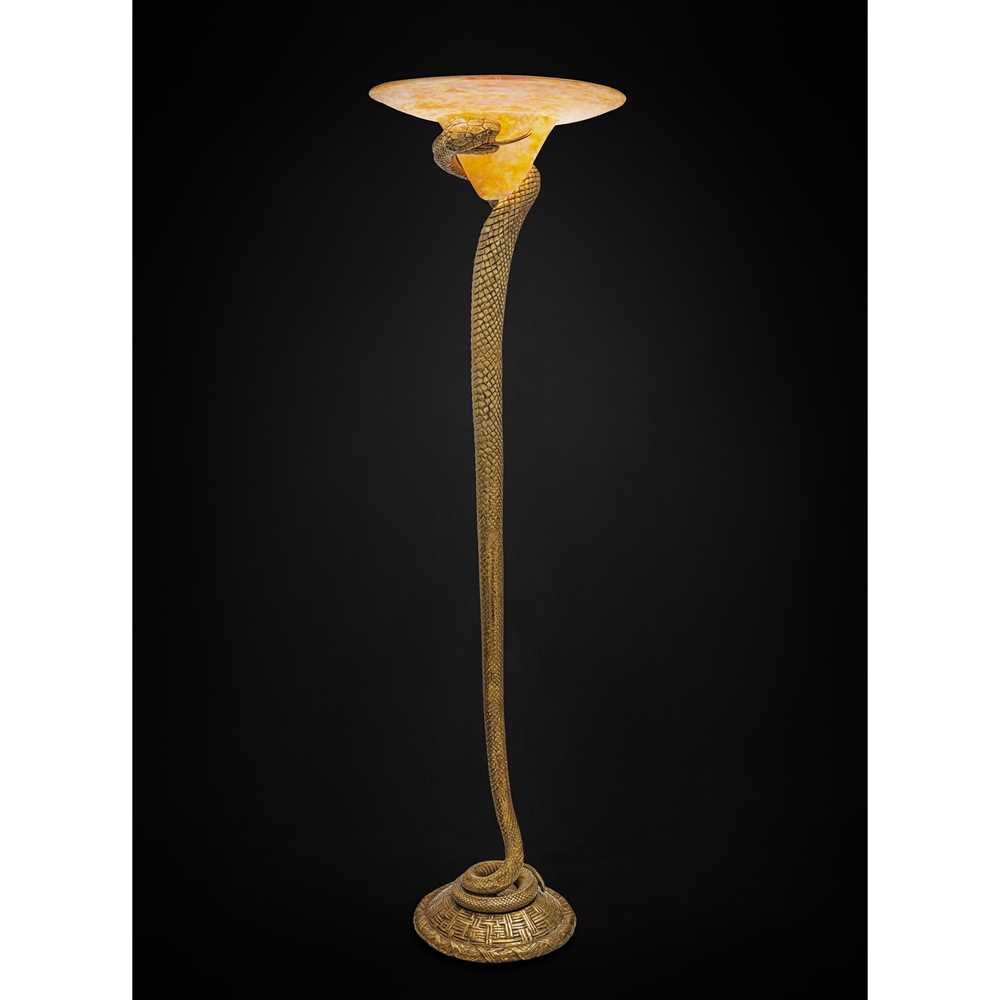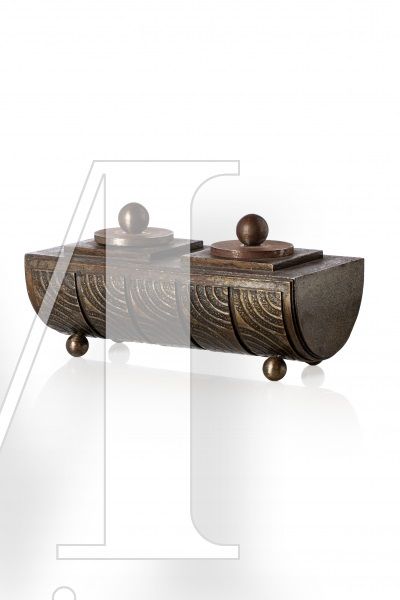PROPERTY OF A NEW YORK COLLECTOR Edgar Brandt "L'Âge d'Or” 1923 Patinated iron, gilt bronze. 106 1/2 x 159 1/4 x 8 in. (270.5 x 404.5 x 20.3 cm) The three medallions executed by Max Blondat (1872-1926). Retailed by Ferrobrandt Inc., New York. The garland of the single female figure signed MAX-BLONDAT-
Provenance Ferrobrandt, Inc., New York Acquired from the above by John Woodman Higgins for the Higgins Armory Museum, Worcester, Massachusetts, 1935 Sotheby's, New York, “Important 20th Century Decorative Arts,” November 22, 1991, lot 508 Claude and Simone Dray, Paris Christie’s, Paris, “Collection Claude et Simone Dray,” June 8, 2006, lot 18 Acquired from the above Exhibited Salon d'Automne, Paris, 1923 International Exhibition of Architecture and Allied Arts, Grand Central Palace, New York, April, 1925 Higgins Armory Museum, Worcester, Massachusetts, circa 1928-1986 Literature The Studio, vol. 88, December 1924, illustrated p. 349 Guillaume Janneau, Le Fer: Ouvrages de Ferronnerie et de Serrurerie à des Artisans Contemporains, Paris, 1924, illustrated pls. 11, 12 “The Architect’s Exhibition,” The International Studio, vol. 81, July 1925, illustrated p. 264 Emile Bayard L’Art appliqué francais d’aujourd’hui, Paris, 1925, illustrated p. 64 Ferrobrandt Inc., (catalogue), New York, 1926, illustrated pl. 3 Joan Kahr, Edgar Brandt Art Deco Ironwork, Paris, 2010, illustrated front and back covers, pp. 93-94 Catalogue Essay Alchemy in Iron The year was 1923; the event was the Salon d’Automne, where French decorative artists displayed their latest designs for carpets, textiles, furniture, silver, and ironwork. At the entrance to the decorative arts section, the enormous grille, L’Àge d’Or appeared, stopping viewers instantly. Wrought smithing was an ancient art, but under the hammer of the artist-blacksmith Edgar Brandt (1880-1960), it was revived. Brandt’s own words tell us a great deal about the Moderne concept of the decorative arts during the early years of the twentieth century. Brandt said: “We are indeed living in the true Iron Age, and the powerful means of modern metallurgy, deployed for the execution of a work of art, conceived of and elaborated on the scale of those means, will provide an artistic spectacle of imposing grandeur.” His dictum was that new techniques gave the artist greater latitude of expression. Brandt said: “Logic and reason point to the artist making use of all that science places at his disposal.” It did not make sense to him to limit oneself to old methods. L’Âge d’Or, a colossal five-panel grille, is an artistic masterpiece that affirms the benefit of utilizing modern methods of ironsmithing. Brandt felt that purist or closed-minded blacksmiths (ferronniers), who used only hammer and anvil, were turning out work that looked back to historicist styles. Therefore, when Brandt built his workshop on the Boulevard Murat in 1920, he employed the latest tools, such as power hammers, stamping machines, milling machines, twisting bars and mechanical presses. He was prescient in adopting the oxy-acetylene welding torch, whereby the iron became its own joining material. The torch fused metallic parts without the older methods of hot and cold forging. Brandt was a consummate smith who mastered the ancient art of the forgeron while still in his teens, but later on, he aligned his personal artistic repertoire with modern industrial methods. By embracing new methods and tools, he augmented the possibilities of wrought iron. With this evolution, Brandt became a major figure in the history of French decorative art. In the 1910s and 1920s Edgar Brandt fulfilled such prestigious commissions as the Mollien stairway in the Louvre (1914), the Grand Théâtre in Nancy (1909-1919), the Tomb of the Unknown Soldier under the Arc de Triumph (1920-1923), as well as the famous screen, Les Cicognes d’Alsace (1922). Additionally, his small objects such as firescreens, wall lights, andirons, torchères, jardinières, and chandeliers, all became coveted decorations for many fashionable homes on several continents. Brandt collaborated with the sculptor Max Blondat (1872-1926) on the grille L’Âge d’Or, which became his chef d’oeuvre. During its installation at the Salon d’Automne, L’Âge d’Or was set in front of a fluted wall, a reference
PROPERTY OF A NEW YORK COLLECTOR Edgar Brandt "L'Âge d'Or” 1923 Patinated iron, gilt bronze. 106 1/2 x 159 1/4 x 8 in. (270.5 x 404.5 x 20.3 cm) The three medallions executed by Max Blondat (1872-1926). Retailed by Ferrobrandt Inc., New York. The garland of the single female figure signed MAX-BLONDAT-
Provenance Ferrobrandt, Inc., New York Acquired from the above by John Woodman Higgins for the Higgins Armory Museum, Worcester, Massachusetts, 1935 Sotheby's, New York, “Important 20th Century Decorative Arts,” November 22, 1991, lot 508 Claude and Simone Dray, Paris Christie’s, Paris, “Collection Claude et Simone Dray,” June 8, 2006, lot 18 Acquired from the above Exhibited Salon d'Automne, Paris, 1923 International Exhibition of Architecture and Allied Arts, Grand Central Palace, New York, April, 1925 Higgins Armory Museum, Worcester, Massachusetts, circa 1928-1986 Literature The Studio, vol. 88, December 1924, illustrated p. 349 Guillaume Janneau, Le Fer: Ouvrages de Ferronnerie et de Serrurerie à des Artisans Contemporains, Paris, 1924, illustrated pls. 11, 12 “The Architect’s Exhibition,” The International Studio, vol. 81, July 1925, illustrated p. 264 Emile Bayard L’Art appliqué francais d’aujourd’hui, Paris, 1925, illustrated p. 64 Ferrobrandt Inc., (catalogue), New York, 1926, illustrated pl. 3 Joan Kahr, Edgar Brandt Art Deco Ironwork, Paris, 2010, illustrated front and back covers, pp. 93-94 Catalogue Essay Alchemy in Iron The year was 1923; the event was the Salon d’Automne, where French decorative artists displayed their latest designs for carpets, textiles, furniture, silver, and ironwork. At the entrance to the decorative arts section, the enormous grille, L’Àge d’Or appeared, stopping viewers instantly. Wrought smithing was an ancient art, but under the hammer of the artist-blacksmith Edgar Brandt (1880-1960), it was revived. Brandt’s own words tell us a great deal about the Moderne concept of the decorative arts during the early years of the twentieth century. Brandt said: “We are indeed living in the true Iron Age, and the powerful means of modern metallurgy, deployed for the execution of a work of art, conceived of and elaborated on the scale of those means, will provide an artistic spectacle of imposing grandeur.” His dictum was that new techniques gave the artist greater latitude of expression. Brandt said: “Logic and reason point to the artist making use of all that science places at his disposal.” It did not make sense to him to limit oneself to old methods. L’Âge d’Or, a colossal five-panel grille, is an artistic masterpiece that affirms the benefit of utilizing modern methods of ironsmithing. Brandt felt that purist or closed-minded blacksmiths (ferronniers), who used only hammer and anvil, were turning out work that looked back to historicist styles. Therefore, when Brandt built his workshop on the Boulevard Murat in 1920, he employed the latest tools, such as power hammers, stamping machines, milling machines, twisting bars and mechanical presses. He was prescient in adopting the oxy-acetylene welding torch, whereby the iron became its own joining material. The torch fused metallic parts without the older methods of hot and cold forging. Brandt was a consummate smith who mastered the ancient art of the forgeron while still in his teens, but later on, he aligned his personal artistic repertoire with modern industrial methods. By embracing new methods and tools, he augmented the possibilities of wrought iron. With this evolution, Brandt became a major figure in the history of French decorative art. In the 1910s and 1920s Edgar Brandt fulfilled such prestigious commissions as the Mollien stairway in the Louvre (1914), the Grand Théâtre in Nancy (1909-1919), the Tomb of the Unknown Soldier under the Arc de Triumph (1920-1923), as well as the famous screen, Les Cicognes d’Alsace (1922). Additionally, his small objects such as firescreens, wall lights, andirons, torchères, jardinières, and chandeliers, all became coveted decorations for many fashionable homes on several continents. Brandt collaborated with the sculptor Max Blondat (1872-1926) on the grille L’Âge d’Or, which became his chef d’oeuvre. During its installation at the Salon d’Automne, L’Âge d’Or was set in front of a fluted wall, a reference















Testen Sie LotSearch und seine Premium-Features 7 Tage - ohne Kosten!
Lassen Sie sich automatisch über neue Objekte in kommenden Auktionen benachrichtigen.
Suchauftrag anlegen